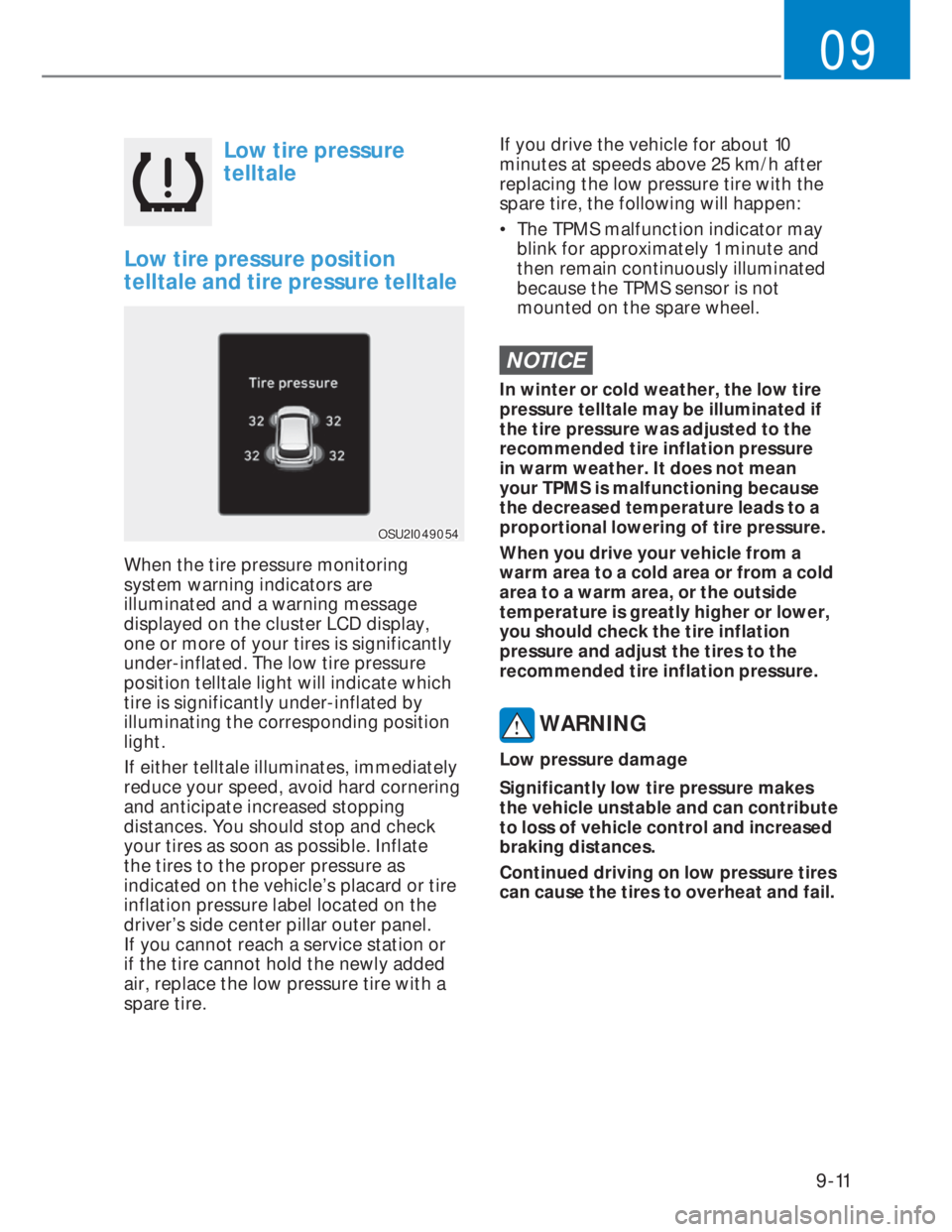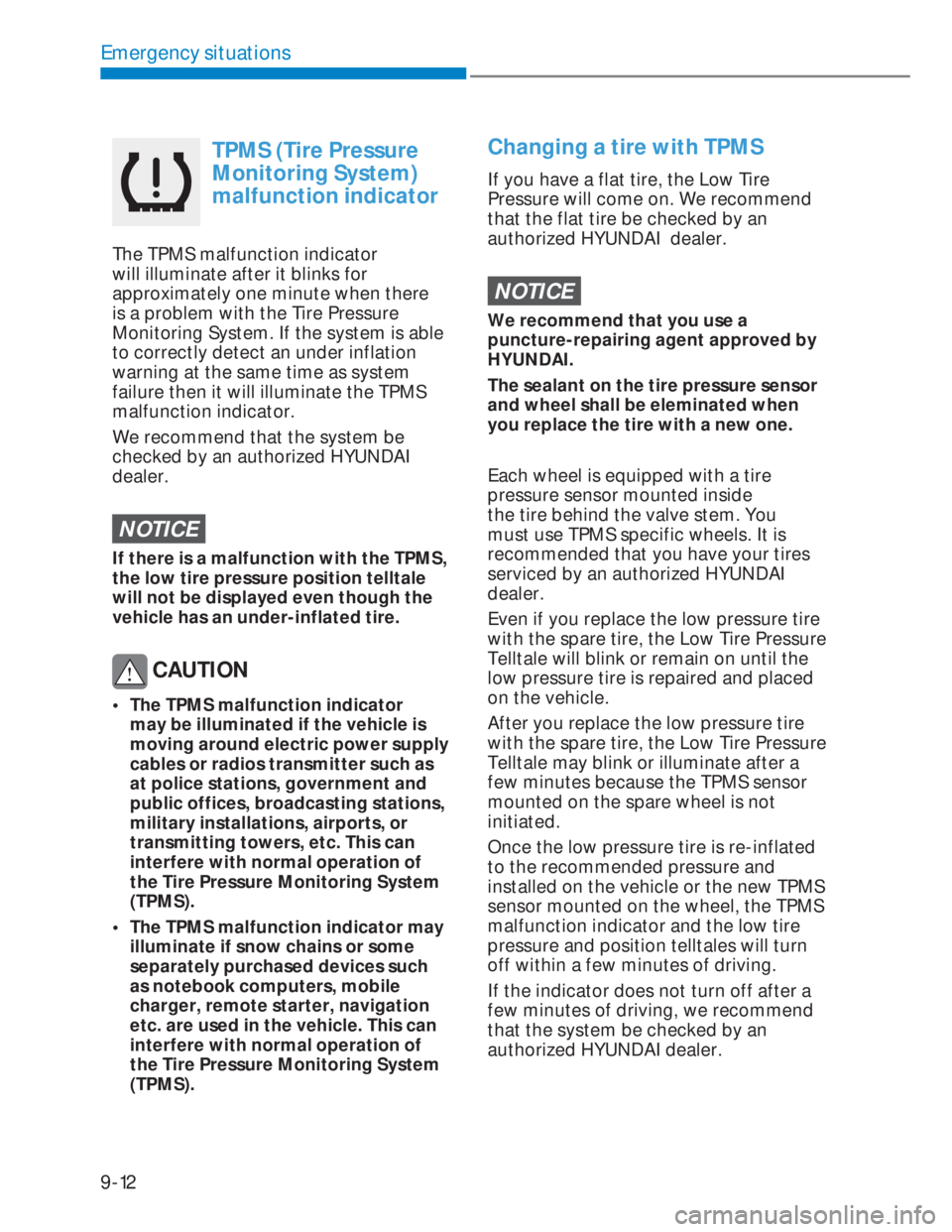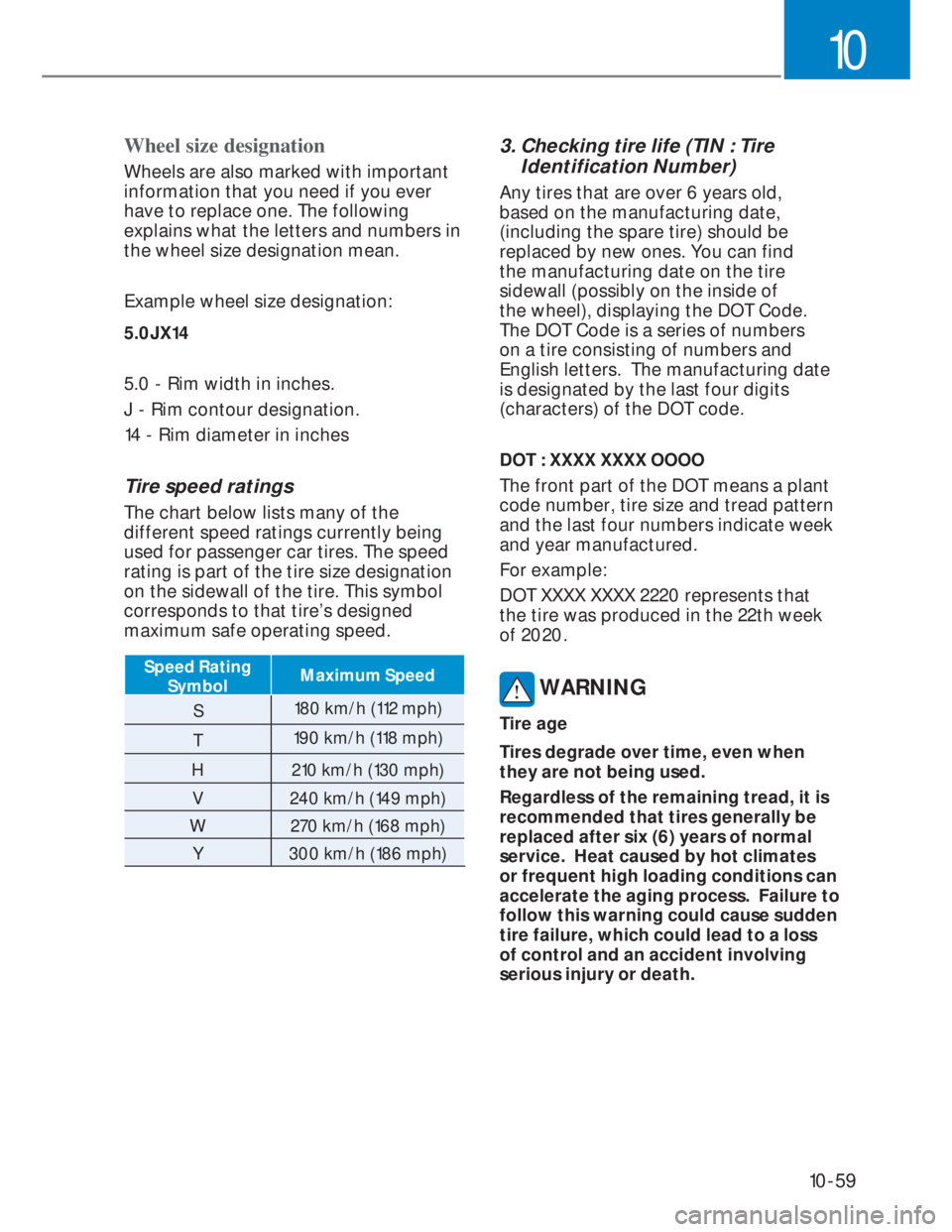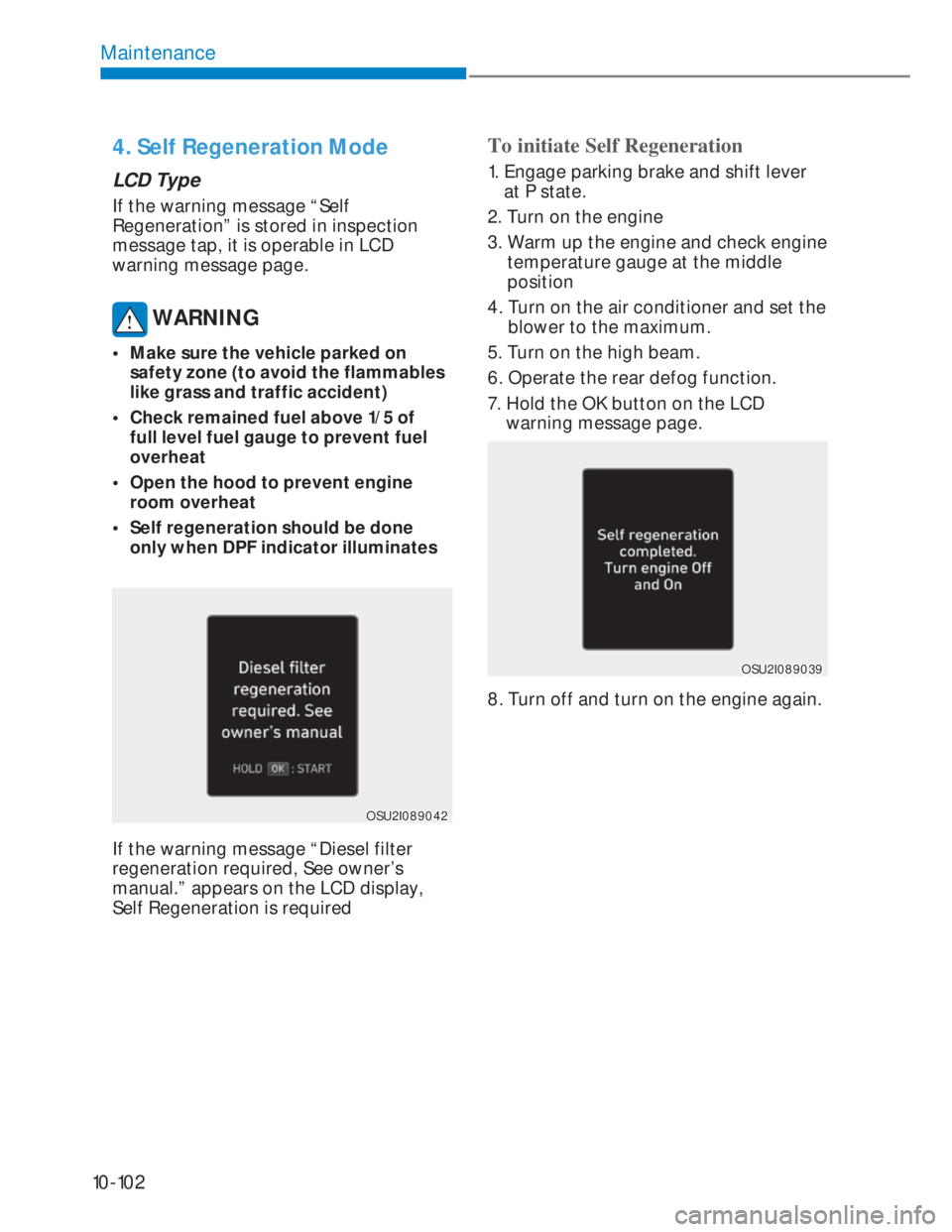display HYUNDAI I20 2022 Repair Manual
[x] Cancel search | Manufacturer: HYUNDAI, Model Year: 2022, Model line: I20, Model: HYUNDAI I20 2022Pages: 444, PDF Size: 8.93 MB
Page 325 of 444

9-11
09
Low tire pressure
telltale
Low tire pressure position
telltale and tire pressure telltale
OSU2I049054OSU2I049054
When the tire pressure monitoring
system warning indicators are
illuminated and a warning message
displayed on the cluster LCD display,
one or more of your tires is significantly
under-inflated. The low tire pressure
position telltale light will indicate which
tire is significantly under-inflated by
illuminating the corresponding position
light.
If either telltale illuminates, immediately
reduce your speed, avoid hard cornering
and anticipate increased stopping
distances. You should stop and check
your tires as soon as possible. Inflate
the tires to the proper pressure as
indicated on the vehicle’s placard or tire
inflation pressure label located on the
driver’s side center pillar outer panel.
If you cannot reach a service station or
if the tire cannot hold the newly added
air, replace the low pressure tire with a
spare tire.
If you drive the vehicle for about 10
minutes at speeds above 25 km/h after
replacing the low pressure tire with the
spare tire, the following will happen:
• The TPMS malfunction indicator may
blink for approximately 1 minute and
then remain continuously illuminated
because the TPMS sensor is not
mounted on the spare wheel.
NOTICE
In winter or cold weather, the low tire
pressure telltale may be illuminated if
the tire pressure was adjusted to the
recommended tire inflation pressure
in warm weather. It does not mean
your TPMS is malfunctioning because
the decreased temperature leads to a
proportional lowering of tire pressure.
When you drive your vehicle from a
warm area to a cold area or from a cold
area to a warm area, or the outside
temperature is greatly higher or lower,
you should check the tire inflation
pressure and adjust the tires to the
recommended tire inflation pressure.
WARNING
Low pressure damage
Significantly low tire pressure makes
the vehicle unstable and can contribute
to loss of vehicle control and increased
braking distances.
Continued driving on low pressure tires
can cause the tires to overheat and fail.
Page 326 of 444

9-12
Emergency situations
TPMS (Tire Pressure
Monitoring System)
malfunction indicator
The TPMS malfunction indicator
will illuminate after it blinks for
approximately one minute when there
is a problem with the Tire Pressure
Monitoring System. If the system is able
to correctly detect an under inflation
warning at the same time as system
failure then it will illuminate the TPMS
malfunction indicator.
We recommend that the system be
checked by an authorized HYUNDAI
dealer.
NOTICE
If there is a malfunction with the TPMS,
the low tire pressure position telltale
will not be displayed even though the
vehicle has an under-inflated tire.
CAUTION
• The TPMS malfunction indicator
may be illuminated if the vehicle is
moving around electric power supply
cables or radios transmitter such as
at police stations, government and
public offices, broadcasting stations,
military installations, airports, or
transmitting towers, etc. This can
interfere with normal operation of
the Tire Pressure Monitoring System
(TPMS).
• The TPMS malfunction indicator may
illuminate if snow chains or some
separately purchased devices such
as notebook computers, mobile
charger, remote starter, navigation
etc. are used in the vehicle. This can
interfere with normal operation of
the Tire Pressure Monitoring System
(TPMS).
Changing a tire with TPMS
If you have a flat tire, the Low Tire
Pressure will come on. We recommend
that the flat tire be checked by an
authorized HYUNDAI dealer.
NOTICE
We recommend that you use a
puncture-repairing agent approved by
HYUNDAI.
The sealant on the tire pressure sensor
and wheel shall be eleminated when
you replace the tire with a new one.
Each wheel is equipped with a tire
pressure sensor mounted inside
the tire behind the valve stem. You
must use TPMS specific wheels. It is
recommended that you have your tires
serviced by an authorized HYUNDAI
dealer.
Even if you replace the low pressure tire
with the spare tire, the Low Tire Pressure
Telltale will blink or remain on until the
low pressure tire is repaired and placed
on the vehicle.
After you replace the low pressure tire
with the spare tire, the Low Tire Pressure
Telltale may blink or illuminate after a
few minutes because the TPMS sensor
mounted on the spare wheel is not
initiated.
Once the low pressure tire is re-inflated
to the recommended pressure and
installed on the vehicle or the new TPMS
sensor mounted on the wheel, the TPMS
malfunction indicator and the low tire
pressure and position telltales will turn
off within a few minutes of driving.
If the indicator does not turn off after a
few minutes of driving, we recommend
that the system be checked by an
authorized HYUNDAI dealer.
Page 398 of 444

10-59
10
Wheel size designation
Wheels are also marked with important
information that you need if you ever
have to replace one. The following
explains what the letters and numbers in
the wheel size designation mean.
Example wheel size designation:
5.0JX14
5.0 - Rim width in inches.
J - Rim contour designation.
14 - Rim diameter in inches
Tire speed ratings
The chart below lists many of the
different speed ratings currently being
used for passenger car tires. The speed
rating is part of the tire size designation
on the sidewall of the tire. This symbol
corresponds to that tire’s designed
maximum safe operating speed.
Speed Rating
SymbolMaximum Speed
S180 km/h (112 mph)
T190 km/h (118 mph)
H 210 km/h (130 mph)
V 240 km/h (149 mph)
W 270 km/h (168 mph)
Y 300 km/h (186 mph)
3. Checking tire life (TIN : Tire
Identification Number)
Any tires that are over 6 years old,
based on the manufacturing date,
(including the spare tire) should be
replaced by new ones. You can find
the manufacturing date on the tire
sidewall (possibly on the inside of
the wheel), displaying the DOT Code.
The DOT Code is a series of numbers
on a tire consisting of numbers and
English letters. The manufacturing date
is designated by the last four digits
(characters) of the DOT code.
DOT : XXXX XXXX OOOO
The front part of the DOT means a plant
code number, tire size and tread pattern
and the last four numbers indicate week
and year manufactured.
For example:
DOT XXXX XXXX 2220 represents that
the tire was produced in the 22th week
of 2020.
WARNING
Tire age
Tires degrade over time, even when
they are not being used.
Regardless of the remaining tread, it is
recommended that tires generally be
replaced after six (6) years of normal
service. Heat caused by hot climates
or frequent high loading conditions can
accelerate the aging process. Failure to
follow this warning could cause sudden
tire failure, which could lead to a loss
of control and an accident involving
serious injury or death.
Page 441 of 444

10-102
Maintenance
4. Self Regeneration Mode
LCD Type
If the warning message “Self
Regeneration” is stored in inspection
message tap, it is operable in LCD
warning message page.
WARNING
• Make sure the vehicle parked on
safety zone (to avoid the flammables
like grass and traffic accident)
• Check remained fuel above 1/5 of
full level fuel gauge to prevent fuel
overheat
• Open the hood to prevent engine
room overheat
• Self regeneration should be done
only when DPF indicator illuminates
OSU2I089042OSU2I089042
If the warning message “Diesel filter
regeneration required, See owner’s
manual.” appears on the LCD display,
Self Regeneration is required
To initiate Self Regeneration
1. Engage parking brake and shift lever
at P state.
2. Turn on the engine
3. Warm up the engine and check engine
temperature gauge at the middle
position
4. Turn on the air conditioner and set the
blower to the maximum.
5. Turn on the high beam.
6. Operate the rear defog function.
7. Hold the OK button on the LCD
warning message page.
OSU2I089039OSU2I089039
8. Turn off and turn on the engine again.